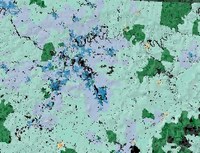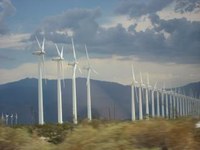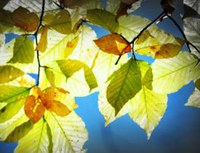Invasive species and forest pathogens
When the introduction or increased activity of invasive or pathogenic plant and animal species dramatically alters the structure and function of ecosystems, the benefits that those ecosystems provide to people are also affected.
Water — Colonization by invasive species and outbreaks of forest pathogens can have important hydrological effects, principally by changing the structure and function of forest vegetation. For example, the widespread and continuing die-off of Eastern Hemlock (Tsuga canadensis) in the Appalachians due to the invasive Hemlock wooly adelgid (Adelges tsugae) can alter stream hydrology, temporarily increasing stormflow peaks and causing long-term decline in total stream yield.
Soils — Highly invasive plants, particularly when they become densely established, can change soil properties in ways that reduce nutrient and water availability for native plants. Soil microbial communities are also negatively affected by some invasive plants across large areas. These changes in soil structure and function can be long-term, negatively affecting native plant communities and ecological restoration efforts.
Timber and nontimber forest products — Outbreaks of insect pathogens on forest trees, when they affect large areas, are one of the most important risk factors for harvested tree species. Large outbreaks can also change forest structure and composition in a way that reduces habitat quality for nontimber forest species such as harvested understory herbs. Dense colonization of forested landscapes by invasive, non-native plants can negatively influence regeneration of native tree species including those with economic value. Invasives can also alter the composition and structure of forests, potentially reducing the overall productivity of marketable timber and nontimber species. The negative effects of forest pathogens and invasives on marketable species may be exacerbated by climate change, forest fragmentation, fire, and other landscape processes which may facilitate outbreaks or invasions.
Carbon storage — Over the short term, forest primary productivity is often significantly reduced after a major tree pathogen outbreak, slowing carbon sequestration. A forest stand can switch from a carbon sink to a source under these conditions depending on outbreak severity, but this process can reverse over the long term as forest productivity recovers. The cumulative impacts of multiple outbreaks across a landscape can reduce carbon storage and sequestration at regional scales, but the overall, long-term results of these dynamics are not well understood. Forest pathogen outbreaks are affected by climate change, because they can become more likely as extreme heat and drought events become more frequent.
 Urbanization
|
 Energy development
|
![Hemlock Wooly Adelgid By Nicholas A. Tonelli from Pennsylvania, USA (Henry's Woods (6)) [CC BY 2.0 (http://creativecommons.org/licenses/by/2.0)], via Wikimedia Commons](https://bobscapes.net/ecosystem-risks-benefits/risks/hemlock-wooly-adelgid/@@images/b0bf0bc4-1b53-4b20-8e38-e82d344bee8c.jpeg)
Invasive species and
|
 Climate change
|
![Wildfires in Eastern U.S. By Glenn Research Center (https://www.dvidshub.net/image/857727) [Public domain], via Wikimedia Commons](https://bobscapes.net/ecosystem-risks-benefits/risks/wildfires-in-eastern-u.s/@@images/0d2bbb65-9ef4-4070-a99f-c36b403f71cf.jpeg)
Wildland fire |
References
Brantley, S. T., C. F. Miniat, K. J. Elliott, S. H. Laseter, and J. M. Vose. 2015. Changes to southern Appalachian water yield and stormflow after loss of a foundation species. Ecohydrology 8(3): 518-528.
Duerr, D. A., and P. A. Mistretta. 2013. Invasive pests—insects and diseases, Chapter 16, 457-508. In D. N. Wear and J. G. Greis, editors, The Southern Forest Futures Project: Technical Report. Gen. Tech. Rep. SRS-178, USDA Forest Service, Southern Research Station: 542 pp.
Elgersma, K. J., and J. G. Ehrenfeld. 2011. Linear and non-linear impacts of a non-native plant invasion on soil microbial community structure and function. Biological Invasions 13(3): 757-768.
Ford, C. R., and J. M. Vose. 2007. Tsuga canadensis (L.) Carr. mortality will impact hydrologic processes in southern Appalachian forest ecosystems. Ecological Applications 17(4): 1156-1167.
Hanson, C., L. Yonavjak, C. Clarke, S. Minnemeyer, L. Boisrobert, A. Leach, and K. Schleeweis. 2010. Southern Forests For the Future. World Resources Institute, Washington, D.C.: 73 pp.
Hicke, J. A., C. D. Allen, A. R. Desai, M. C. Dietze, R. J. Hall, D. M. Kashian, D. Moore, K. F. Raffa, R. N. Sturrock, and J. Vogelmann. 2012. Effects of biotic disturbances on forest carbon cycling in the United States and Canada. Global Change Biology 18(1): 7-34.
Keyser, T., J. Malone, C. Cotton, and J. Lewis. 2014. Outlook for Appalachian-Cumberland forests: a subregional report from the Southern Forest Futures Project. General Technical Report SRS-GTR-188. USDA Forest Service, Southern Research Station: 83 pp.
Kourtev, P. S., J. G. Ehrenfeld, and M. Häggblom. 2002. Exotic plant species alter the microbial community structure and function in the soil. Ecology 83(11): 3152-3166.
Kourtev, P. S., J. G. Ehrenfeld, and M. Häggblom. 2003. Experimental analysis of the effect of exotic and native plant species on the structure and function of soil microbial communities. Soil Biology and Biochemistry 35(7): 895-905.
Kuhman, T. R., S. M. Pearson, and M. G. Turner. 2010. Effects of land-use history and the contemporary landscape on non-native plant invasion at local and regional scales in the forest-dominated southern Appalachians. Landscape Ecology 25(9): 1433-1445.
Lemke, D., C. J. Schweitzer, W. Tadesse, Y. Wang, and J. A. Brown. 2013. Geospatial assessment of invasive plants on reclaimed mines in Alabama. Invasive Plant Science and Management 6(3): 401-410.
Miller, J. H., D. Lemke, and J. Coulston. 2013. The invasion of southern forests by nonnative plants: current and future occupation, with impacts, management strategies, and mitigation approaches, Chapter 15, 397-456. In D. N. Wear and J. G. Greis, editors, The Southern Forest Futures Project: Technical Report. Gen. Tech. Rep. SRS-178, USDA Forest Service, Southern Research Station: 542 pp.
Shifley, S. R., F. X. Aguilar, N. Song, S. I. Stewart, D. J. Nowak, D. D. Gormanson, W. K. Moser, S. Wormstead, and E. J. Greenfield. 2012. Forests of the Northern United States. Gen. Tech. Rep. NRS-90, USDA Forest Service, Northern Research Station: 202 pp.





















